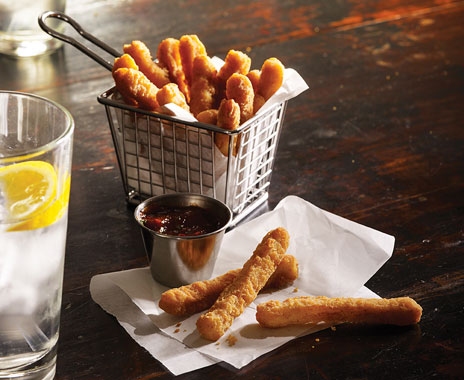For restaurant operators, the menu is the heart of their business. It is their product. It is what brings people in the door. With some thoughtful strategy behind it, however, a menu can also be a tool for sustaining and growing a business for the long run.
Balancing a standard menu with rotating items has multiple benefits. For the customer, new items enhance the experience by adding an element of discovery to the visit. For operators, new items present an opportunity to pamper regulars, bring new people in, and continually develop and improve the menu using customer feedback.
The downside of changing the menu strategy is the cost associated by frequently introducing new items. The operation has to be aligned to the new dish, both in the kitchen and at the front of the house. Menus have to be reprinted, staff has to be trained, and space has to be made for new ingredients. Change can be expensive.
There’s a way to reduce the costs, however, without losing the benefits of introducing new items to a menu. Appetizers are a great way to test out new flavors with customers without the full investment of adding a new entrée.
Rotating Appetizers
The greatest advantage of a rotating appetizer menu strategy is people are more willing to try them. Because appetizers can be shareable, consumers can venture into new culinary territory without risking the entrée. If they don’t like it, no harm done.
For operators, developing and introducing a new appetizer is not as disruptive as introducing an entire entrée. For quick-service restaurants that don’t have the financial flexibility of the major players, an appetizer allows for more experimentation and even more direct contact with the customer. To keep ingredient costs down, the same ones can be used, but with a new twist. Seasons and holidays are great drivers for rotating items, not only because they present a timely opportunity, but because they also come with their own unique flavor profiles. Ethnic flavors also can add an element of surprise and contrast, but that, of course, depends on the flavor palette of your menu.
The key is thinking of ways to expand the menu with something different, but making sure it fits with the restaurant’s identity. A rotating schedule will give consumers a chance to get familiar with each new item. Overdoing it can be confusing for people, so changes should be made every four months or so.
It’s important to keep in mind that many customers are coming to the restaurant with an idea of what it offers, or even with a particular dish in mind. The core menu has to be between 60 to 70 percent static, which leaves plenty of room for research and development. Keep in mind, rotating appetizers are not just to bring in more people. With customer feedback on which rotating appetizers work and which don’t, a menu can be perfected so the restaurant is not getting stuck with a core menu that worked, but is getting tired.
Keeping things fresh
When a cook has been making the same recipe for a long time, the passion can get lost, and the task may become repetitive. Customers can tell when a dish wasn’t made with excitement and pride. New recipes keeps things fresh in the kitchen and it gives staff a chance to use their creativity and contribute to the menu development process.
A fresh kitchen will put out a fresh menu, and people will be able to tell. Even though the menu should be mostly static, it should also feel dynamic. It is good practice to make regular updates at least every four months. The idea is not to make major changes, but to introduce one or two new dishes, at most, to the core menu, along with minor details.
This is where the appetizers can be a great resource for menu development in the long run. The menu items that were a hit with customers, or the ones asked for after they were taken off the menu, should be considered as new entrees. Sales should be good if the decision to introduce the new entrée to the menu was made with strong consumer feedback, so there is little risk there. Staff will be familiar with the ingredients and the recipes as well.
A rotating appetizer strategy makes sense as long as there is a strict and thoughtful schedule to the process. Adding appetizers on a whim or without any order will make it difficult to generate expectation with customers. If you want to have a comprehensive menu development strategy to ensure the future well being of your operation, start with appetizers.











